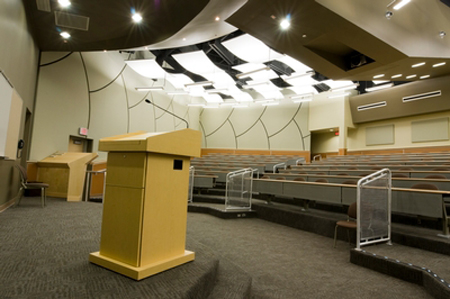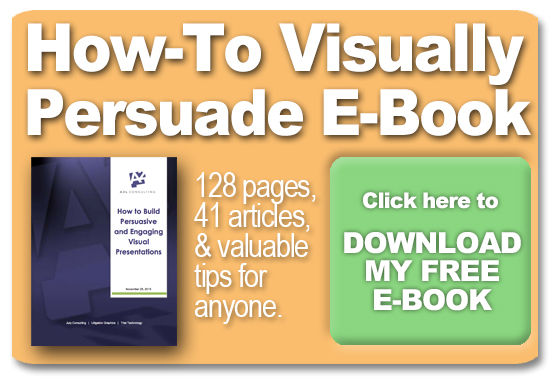 by Ken Lopez
by Ken Lopez
Founder/CEO
A2L Consulting
I sit on the board of a university, and I am passionate about delivering high-quality advice and guidance to the institution. To improve the quality of my work and our board's work, board members are afforded the opportunity to attend a conference focused on how higher education can best be managed and delivered.
At this three-day conference, a mix of keynote speeches and a series of small-group sessions creates an environment for learning about topics like effective university marketing, managing a university in an era of tight budgets, the value of a liberal arts education vs. skills training and much more.
The conference material is interesting and valuable for me. However, my full-time job of helping litigators present at their very best is always on my mind. So, I love that a conference like this gives me a chance to see how others present, and I learn something about presentation technique from every presentation.
There are two types of presenters at this conference. Several, like Dan Pink, are hired, world-class presenters who are well-known for their speaking quality. Most others, are university leaders and other experts in the field of higher education.
Dan Pink's one-hour presentation was flawless. He delivered high-value content, he used visuals to complement his message, he morphed his message to match the needs of the audience, he delivered to all three learning styles, he used humor very well and he used a variety of rhetorical techniques to make his message memorable and understandable. He, a Yale-trained lawyer himself, presented like all litigators should present. Full disclosure: since Dan Pink mentioned A2L (then Animators at Law) in his second best-selling book, I'm certain he can do no wrong. With that caveat, he was still a perfect presenter.
This brings me to the other presenters at the conference. A reminder, these are some of the world's top people in higher education. So, how well did they present? Imagine the worst CLE or classroom setting you've been in with a presenter reading bullet points. This was worse. Much worse. And I am disturbed by it.
I attended four break-out sessions with fifty or so people in the room. Each room had a screen and projector set up. Did the presenters use the technology? Not once. Not even in the session about technology in education! I've not seen anything like it in this century. Some of the best people in higher education failed to show any understanding of how people actually learn. Yikes.
So, what can litigators learn about presentation style from some of the world's top educators? To quote a famous song, "Absolutely nothin'. Say it again."
Well, that's not entirely accurate. Lawyers should actually pause for a moment and reflect on how far they have come these past twenty years. After all, the state of presentations in higher education is apparently quite similar to where the legal industry found itself in the 1990s. Many courtroom presentations and even many CLE presentations are actually quite good now.
When I say "good" I certainly don't just mean pretty. Good presentations deliver results. They inspire, they inform or they do both. They use every trick in the book to do so. If you are still reading a lecture to a group of people and you want them to understand complicated material and take action, you are truly showing up to a gunfight with a knife.
To help any presenter, whether a trial presentation in the courtroom or a corporate presentation, I have listed below some of A2L Consulting's most important articles related to making good presentations. If you are a presenter who is using visuals aids, using complementary rather than competing graphics, avoiding bullet points, not reading your slides, you're ahead of 90% of your peers and you are far ahead of higher education. Use these articles and resources below to become your best.
Other A2L articles and materials related to delivering a great presentation:
- Don't Use PowerPoint as a Crutch in Trial or Anywhere
- 10 Things Litigators Can Learn From Newscasters
- Why Reading Your Litigation PowerPoint Slides Hurts Jurors
- 12 Ways to SUCCESSFULLY Combine Oral and Visual Presentations
- 12 Reasons Bullet Points Are Bad (in Trial Graphics or Anywhere)
- Presentation Graphics: Why The President Is Better Than You
- WATCH: PowerPoint Litigation Graphics - Winning by Design™
- 21 Reasons a Litigator Is Your Best Litigation Graphics Consultant
- 14 Tips for Delivering a Great Board Meeting Presentation
- 6 Studies That Support Litigation Graphics in Courtroom Presentations
- FREE DOWNLOAD: How to Deliver a Great Presentation
- FREE DOWNLOAD How to Build Persuasive Visual Presentations
- FREE DOWNLOAD: Storytelling for Litigators: Building a Great Narrative
- Every Litigator Should Watch Scott Harrison Deliver This Presentation
- 16 Trial Presentation Tips You Can Learn from Hollywood
- How to Structure Your Next Speech, Opening Statement or Presentation
- 5 Chart Tricks and Cheats to Watch Out For





Leave a Comment